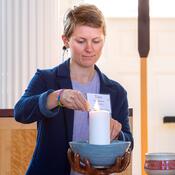The 2021 Woodbury Leadership Workshop with the Rev. Dr. Kirk Byron Jones (MDiv ‘81)
A link to the full lecture can be found at the bottom of this page.
by kathy leonard czepiel
The Reverend Doctor Kirk Byron Jones (MDiv ‘81) knows firsthand how important self-care is. He literally wrote the book on it. A 20th anniversary edition of his popular Rest in the Storm: Self-Care Strategies for Clergy and Other Caregivers has just been published, and Dr. Jones shared some new thoughts on the subject as this year’s keynote speaker for the Woodbury Leadership Workshop, held virtually on February 20th.
 Dr. Jones’s expertise in self-care for clergy was hard-earned. In his early thirties, he was a preacher, a husband, a father of young children, finishing his PhD, and he was frequently saying “yes” to preaching at revivals that lasted for days. His plate, it turned out, was too full. While preaching to a crowd one night in Pennsylvania, about five minutes in, he “came to a halt,” he told the Woodbury audience of nearly 70 Zoom attendees. “For a while, it was OK because, you know, in the African-American church, people talk back to you.” He recalled the words from the congregation: “Mmmhmmm, All right, Amen… Take your time, preacher” and, finally, “Help him, Lord!” On that fateful night, Jones sat down, unable to continue.
Dr. Jones’s expertise in self-care for clergy was hard-earned. In his early thirties, he was a preacher, a husband, a father of young children, finishing his PhD, and he was frequently saying “yes” to preaching at revivals that lasted for days. His plate, it turned out, was too full. While preaching to a crowd one night in Pennsylvania, about five minutes in, he “came to a halt,” he told the Woodbury audience of nearly 70 Zoom attendees. “For a while, it was OK because, you know, in the African-American church, people talk back to you.” He recalled the words from the congregation: “Mmmhmmm, All right, Amen… Take your time, preacher” and, finally, “Help him, Lord!” On that fateful night, Jones sat down, unable to continue.The Rev. Dr. Jones broke into delighted laughter as he retold the story to the Andover Newton community—“holy laughter,” as one attendee called it. But there was nothing to laugh about that night in Chester. “I was in the throes of something called burnout,” Dr. Jones said. “Sleeplessness, panic attacks, nervousness, heart palpitations. It was a horrible, horrible time.”
That experience led to intense self-reflection and, eventually, Rest in the Storm. The book has nurtured countless clergy through similarly trying times and continues to do so today. “Still all too pervasive in ministry is the belief that links faithful service to tireless effort,” Dr. Jones writes in the book’s new introduction. “…I am convinced, now more than ever, that substantial personal and social offering hinges on choosing to deliberately care for ourselves.”
 In her introduction of Dr. Jones to the Andover Newton audience, third-year MDiv student Tara Humphries said she keeps her copy of Rest in the Storm, “pretty much every line of which is highlighted,” on her bedside table. It is, she asserted, “a work no less groundbreaking and prophetic today than when it was published 20 years ago.”
In her introduction of Dr. Jones to the Andover Newton audience, third-year MDiv student Tara Humphries said she keeps her copy of Rest in the Storm, “pretty much every line of which is highlighted,” on her bedside table. It is, she asserted, “a work no less groundbreaking and prophetic today than when it was published 20 years ago.”Dr. Jones’s lecture itself was a form of self-care—an opportunity for friends, colleagues and classmates to see one another and to receive words of support and assurance from an “Andover Newton treasure,” as Humphries described the speaker. Participants listened from their studies and living rooms and kitchens, often nodding and smiling, some taking notes and even consulting the book itself. Sitting at the desk in his own paneled office, wearing not a robe but a blue polo shirt, Jones nevertheless spoke like a preacher, calling out the names of people present as he went, repeating his phrases for emphasis, encouraging others with a sparkle in his eyes.
This was the first Woodbury Leadership Workshop to be given on Zoom and the first to be offered free of charge, two shifts in an Andover Newton tradition that stretches back more than 50 years. The workshop was named for the Woodbury family of First Baptist Church in Worcester, Massachusetts, who recognized the growing “importance of administrative leadership to ministry,” Dean Sarah Birmingham Drummond told the audience. Originally known as the Woodbury Management Workshop, the name was updated in 2005 to reflect the need for “not just managing but leading in new and creative directions,” Dean Drummond said. The series is a through-line for Andover Newton, offering “continuity for Andover Newton where we’ve been through a lot of change.”
 That change includes not only the move to New Haven and Yale but also, of course, the upheaval of a pandemic that, for many clergy, has posed the greatest challenges in recent memory. In that context, Dr. Jones’s lessons were especially welcome. He outlined the three main points of the original text of Rest in the Storm: take time for yourself; watch your pace, remembering that “God does not need your hurry”; and learn to be still. The 20th anniversary edition includes two new chapters. One titled “Cultivating Meaningful Friendships” addresses an area of his life that Dr. Jones writes he had “under-lived”—a common problem for clergy. “The statistics indicate that clergy are susceptible to this, not having many friends,” he told attendees. Recognize the blessings of friendship, he advised, seeking those with whom you can find both companionship and the opportunity to be authentically yourself. In the second new chapter, “Unleashing Your Dynamic Creativity,” Dr. Jones points to the expression of God the Creator in us. “Creativity is not just what God does,” he writes. “Creativity is who God is. That is why the power to create is in us all. Believe in your creative offering to the world.” He includes in the chapter a list of “Ten Ways to Unleash Your Creativity” and “Twelve Ways to Become a More Creative Church.”
That change includes not only the move to New Haven and Yale but also, of course, the upheaval of a pandemic that, for many clergy, has posed the greatest challenges in recent memory. In that context, Dr. Jones’s lessons were especially welcome. He outlined the three main points of the original text of Rest in the Storm: take time for yourself; watch your pace, remembering that “God does not need your hurry”; and learn to be still. The 20th anniversary edition includes two new chapters. One titled “Cultivating Meaningful Friendships” addresses an area of his life that Dr. Jones writes he had “under-lived”—a common problem for clergy. “The statistics indicate that clergy are susceptible to this, not having many friends,” he told attendees. Recognize the blessings of friendship, he advised, seeking those with whom you can find both companionship and the opportunity to be authentically yourself. In the second new chapter, “Unleashing Your Dynamic Creativity,” Dr. Jones points to the expression of God the Creator in us. “Creativity is not just what God does,” he writes. “Creativity is who God is. That is why the power to create is in us all. Believe in your creative offering to the world.” He includes in the chapter a list of “Ten Ways to Unleash Your Creativity” and “Twelve Ways to Become a More Creative Church.”  A question-and-answer period led by third-year MDiv student Dawn Jefferson followed Dr. Jones’s talk, with opportunities for participants to dig deeper into some of the issues raised, including bivocational journeys, when to seek professional help, how to help your congregation seek rest, how to respond to those upset by your self-care time, leading a church in the time of COVID, and what Dr. Jones has called “sanctified negligence” (“Some yeses are unholy, and some nos are holy”). The answers weren’t easy, and Dr. Jones assured the group of one certainty: the work of finding “rest in the storm” is an ongoing pursuit. “I have not arrived,” he told them. “I’m still on the journey.”
A question-and-answer period led by third-year MDiv student Dawn Jefferson followed Dr. Jones’s talk, with opportunities for participants to dig deeper into some of the issues raised, including bivocational journeys, when to seek professional help, how to help your congregation seek rest, how to respond to those upset by your self-care time, leading a church in the time of COVID, and what Dr. Jones has called “sanctified negligence” (“Some yeses are unholy, and some nos are holy”). The answers weren’t easy, and Dr. Jones assured the group of one certainty: the work of finding “rest in the storm” is an ongoing pursuit. “I have not arrived,” he told them. “I’m still on the journey.” Throughout, he referred to the central metaphor of Rest in the Storm, which comes from the familiar image in Mark 4:35-41 of Jesus asleep in the back of a boat in a storm. Before the crisis that changed his way of thinking about self-care, Dr. Jones said, “I never saw Jesus in the back of the boat. I was so used to preaching about Jesus on the bow quieting the storm.” He shared with the gathering a line drawing made by his closest friend, the late Rev. Dr. Cedric Kirkland Harris. In it, a simple curved line represents the boat, with three sticks at one end (the disciples), an oval at the other (the sleeping Jesus), a single fish, and a funnel for the storm. A lone wave rocks the boat upward.
“We cannot be certain of all that Jesus did while he was in the back of the boat,” Dr. Jones read aloud from the third chapter of Rest in the Storm, “but we know there were some things that he did not do”: preach, teach, heal, engage in ministry. “We must learn to make it to the back of the boat if we are to overcome self-violence in ministry,” he read. “… It is the back-of-the-boat time—the ‘off’ time—that makes the bow-of-the-boat time—the ‘on’ time—possible.”
